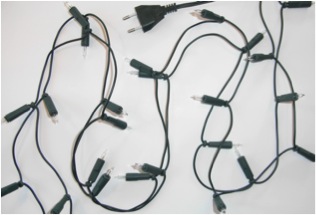Series Circuits

If you combine two or more consumers (e.g. light bulbs, resistances) with conductors in such a way that they are in line without
crosspoints, then you hace created a series circuit. The consumers are like a chain of pearls on a string.
Because there are no branches, the amperage is always the same in series circuits. No matter where you measure it, the amperage is the same in the entire circuit.
The voltage, on the other hand, drops at every consumer in series circuits. How high the voltage ist, depends on the consumer.
The sum of all partial voltages equals the total voltage.
The total resistance in a series circuit is the sum of all partial resistances:


Fairy lights ( = Lichterkette, wörtl. Feenkette) is an example in your everyday life:
Most of them have series circuits. You can see that if one little light bulb is damaged or if you take it away,
all the others go out, as well. That's because all the light bulbs share the same circuit, they are in line.
If this circuit is broken, no current can flow. So one light bulb can work like a switch.
Because of this, there are some fairy lights with parallel circuits to buy. Here the other light bulbs will still glow
if one of them is damaged. (If you want to know more about that and how this works, you should check the tool box for "parallel circuits").
